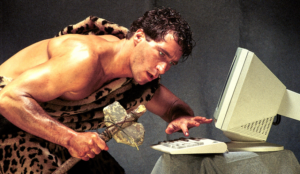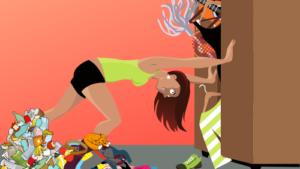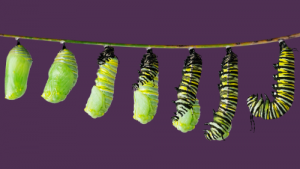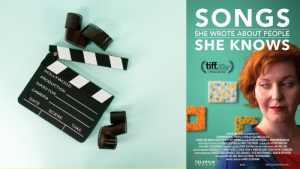Posts by Jan O'Hara
If you were on a message board anywhere on January 2nd, you probably saw a version of the above meme. When we glimpsed it, most of us responded with rueful laughter, and for good reason. This is the season of ruthless self-improvement, when we’re all obsessed with becoming fitter, richer, smarter, or for our purposes, doing something to enhance our writing career.
We also understand that change is hard and willpower has its limits. When challenges arise and we fall short of our ideals, it’s easy to succumb to All or Nothing thinking and like the meme-lady above, become permanently derailed.
Good behavioral change programs work to future-proof their clients against such a relapse. In short, they:
How does this work in real life? For one of my favorite examples, please check out Walking with Peety: The Dog Who Saved My Life.
Briefly, we meet the narrator, Eric O’Grey, in a moment of crisis. A few years back, he suffered a devastating financial and reputational loss brought about by several decisions that can only be described, if you’ll forgive the impenetrable medicalese, as distinctly bone-headed. This necessitated a cross-country move to a community that remains foreign to him, largely because he works from home and chooses to live as a shut-in.
He is morbidly obese and diabetic. His health injuries have accumulated to the point they threaten his much-diminished income. And the final blow? A recent and very public humiliation about his body shape that has left him hopeless and adrift, to the point of being suicidal.
Fortunately, he decides he’ll make one last good-faith effort at change. He reaches out to a naturopath who spends hours with him, gently getting a sense of his whole life, not just his weight loss goals. He leaves with specific dietary advice, a sheaf of simple, printed recipes, a shopping list, and skin in the game in the form of six months of prepaid and pre-booked weekly follow-up appointments.
But the naturopath’s stroke of genius—the suggestion that helps bullet-proof Eric against a relapse when the scale disappoints him, when someone comments negatively on his body, or when he becomes too tired to cook a homemade meal, is two-pronged. She suggests a twice daily short walk and that he should consider adopting a dog. She even recommends a local shelter and sends him home with its contact information.
And when Eric follows through and gets matched to a rescue he renames Peety, difficult aspects of the health program seemingly lock into place. Peety’s innocence and unconditional love, plus his former life of deprivation, all call upon Eric’s conscience to do right by him.
Then there are the practicalities. For example, the outdoor walks, which Eric might’ve blown off if left to his own devices? Non-negotiable. The accidental encounters with his neighbors and the ice-breaking function of a pet? Routine. The ability to […]
Read MoreI lost a beloved aunt during the pandemic, not from Covid itself (though it kept me from attending her bedside), but from a galloping neurologic illness. Later, when things opened up to the point her husband could conduct a celebration of life, I was honored to be asked to help eulogize her.
How do you condense the essence of a person into a few short minutes that will hopefully promote catharsis and healing in yourself and your fellow mourners?
While other eulogists spoke to my aunt’s professional accomplishments (considerable) and her social outreach (intergalactic), I was the relative who had known her the longest. I decided my role was to describe the arc of her larger life. Also, to make clear that the vital, conscientious and fiercely loving woman we all knew had been visible from her earliest years.
An Intersection with Fiction
Around the same time period, I was drafting a holiday romance that required me to level-up my characterization abilities, and it wasn’t going well.
Someone once said that there are only two major plot constructs in fiction: either a person goes on a journey or a stranger comes to town. Well, I realized that to that point, all the fiction I had published dealt with people on the move.
My first book involved a stowaway and an athlete-turned-tour guide who met on a cross-continental bus journey. The second, an employee on a compulsory business trip in Jamaica. My most recent, a woman who’d gone deep undercover, so that her every possession had been curated to hide her true identity.
This time around, however, I was bringing my heroine back to the Colorado location she had fled some five years previously. I had an entire small town to terraform and populate, plus the hero’s ranch to create and imbue with familial backstory. And all this vast white canvas was intimidating to the point of paralysis, mostly because I still didn’t have a handle on my main character. Should I craft a landscape to set her in, and see how that shaped her character, or should I do the reverse?
I really couldn’t see the path forward, and on top of my pandemic-engendered writing rustiness, it just all felt overwhelming.
Collision of Sentiment and the Novella
But what are eulogies if not, in essence, a character sketch, and the stories I chose to tell about my aunt, the highlight reels of her life where it intersected with mine? And so, somehow, with my writing and the celebration occurring in synchrony, glimmers of a useful characterization progress began to reveal themselves.
One universally resonant anecdote regarding my aunt had to do with her amazing hospitality skills. Nearly every year, she’d invite family and friends to a Christmas holiday feast. You’d enter an immaculate house—often freshly painted for the occasion—that was filled with delicious aromas, the buzz of happy conversation, and laughter. After an incredible meal, to which you were allowed to contribute a side dish—more to appease your sense of responsibility and allow you to feel comfortable than because she actually wanted help—she’d send you home with a platter of dessert she’d spent weeks making, though she never ate it herself.
Are you familiar with confetti squares? […]
Read MoreA while back I wrote a post on how I use the binder in Scrivener to delineate a scene’s geographic location, POV character, location in the manuscript, and more. Because it spawned useful discussion, I thought to share another procedural trick that I find essential.
I use it at least two or three times per manuscript, when I’ve resolved the bigger story questions and am polishing at the sentence or paragraph level. Inevitably, I’ll reach a lengthy passage of important activity and know most of the ingredients are already there, but there’s something off about their action-reaction sequence.
Alternatively, I need to delete something/work in something additional, and the alterations are throwing off the current passage’s rhythm or tone.
In my case, this typically happens in dialogue-heavy scenes where the existing passage contains the right pacing or liveliness, so while I’m making my changes, I’d love to preserve the original chemistry and flow.
Before I discovered the Bread Machine Editing Process™ (title explanation to follow), I tried a number of other solutions. I’ll mention them here because they have their place in a self-editor’s toolbox.
Potential Self-Editing Procedures
One option is to simply save the original passage and open a subdocument, cutting and pasting to rework the difficult portion until I am satisfied.
But if I’m dealing with a section that extends beyond a page or so, my brain has a hard time juggling all the potential action-reaction sequences. To pin them down, I might end up creating four or five slightly different subdocuments, in the process giving myself a raging headache.
Another choice is to reduce the passage to a sequence of named beats and simply move the beat titles around—on paper or computer—until their order makes sense.
Sometimes this works for me. But more often than not, when I replace the beat name with the text it’s meant to represent, I discover the prose’s magic has been lost.
On occasion, paper and printer have rescued me. I’ll print out the passage, cut it into the chunks of prose that must stay affixed to one another, and rearrange until satisfied. This makes it easy to remove specific sentences altogether, or add a scrap of paper with new content to assist with logic or flow. Under ideal circumstances, this definitely works.
But what if you don’t have access to the necessary stationery supplies or a large enough surface to see the whole sequence you’re working on? (For example, you’re traveling or writing in a coffee shop.)
What if you’re working outdoors, where a breeze constantly threatens to rearrange your paper slips? Or indoors, with two cats who like to swagger across your working surface, and a black lab who takes personal affront at their arrogance?
What if you need to insert bridging text, and your handwriting can’t keep pace with your ideas?
This is where the Bread Machine Editing Trick™ can prove handy, as it basically is a digital mimic of the paper and printer technique. (I’ve nicknamed it the BMET because, if you’ve ever owned one of those appliances, you’ll recall their emphasis on adding the ingredients in the correct order. Add the dry ingredients before the wet, for example, and expect to extract a hockey puck rather than a loaf with the perfect crumb.)
The BMET’s […]
Read MoreA writing goddess visited my city recently. Elizabeth Gilbert. Ever hear of her? She of Eat, Pray, Love and Big Magic fame? When given the chance to brush up against such a figure, I rarely refuse. So when an author friend expressed her willingness to drive several hours and accompany me to EG’s event, I was quick to agree.
I hoped to leave with a few writing tidbits for myself but also thought to act as your eyes and ears.
Since Covid, I have been a comparative hermit, so my impression of the evening was influenced by many post-pandemic milestones. First time seeing my companion in four years, for example. First dinner in a fancy restaurant. First glimpse of the new downtown train station with its burgeoning homeless population. First occasion among two thousand, mostly unmasked people.
EG presented herself much like her TED Talk: funny, insightful, warm, observably humble. She talked about her earlier book tour for Big Magic and alternately had us in stitches or tears.
She said her full-time job is taking care of her mental health so that her part-time job can be the actual writing. And with further prodding, she described some strategies she uses to overcome her creative roadblocks. I won’t detail those here. I suspect they’re contained within her now-retired podcast or her book, which remains in my groaning To Be Read pile.
Then she opened the floor up for questions, which she predefined as a single sentence that ended in a question mark. She also asked us not to eat up the time with gushing. That she was grateful for our gratitude, but our presence in the auditorium served as tribute enough.
Despite her attempts to set boundaries around her stardom, some people were still overcome by outbursts of adulation. (Maybe the famously polite Canadian constitution asserting itself, or maybe that’s just what she deals with on the regular.)
Anyway, I thought of you in that moment, my dear Unboxeders. Actually visualized myself striding up to a mic and asking what one piece of advice she would have for you all. Before I could wrestle my shyness into submission, someone beat me to it.
And her answer, to the best of my recollection and note-taking capabilities? “Don’t let the terrorist inside your head stop you [from writing your book]. Be more curious than afraid.”
The reason I decided to write this column is that I left the evening feeling thoughtful, buoyed, but also somewhat discomfited. My uneasiness wasn’t because of anything EG said, but rather the way a certain subset of the audience received her hard-won self-knowledge. They seemed desperate to believe in what she offered as possible creativity hacks, at times reminding me of this snippet of dialogue, taken from Monty Python’s Life of Brian, in which an ordinary man, born in the stable next door to Jesus, is mistaken for his holy neighbor:
Brian: …Will you please listen? I’m not the Messiah! Do you understand? Honestly!
Woman: Only the true Messiah denies his divinity!
Brian: What? Well, what sort of chance does that give me? All right, I am the Messiah!
Crowd: He is! He is the Messiah!
As I looked at those eager, adoring, and therefore vulnerable people, I felt a wave of protectiveness […]
Read MoreIf you’re in a non-writing phase and frustrated, several recent Writer Unboxed posts might speak to your lack of production. They address the seasonal nature of writing careers, the need to respect creative limitations, and how to cope when life gets in the way.
This is all well and good. I support this advice one hundred percent.
But what if, as per Kelsey Allagood’s recent post, some part of you knows fatigue and overwhelm aren’t your issue? What if somehow, despite a calendar that could be cleared and an express desire to write, your efforts can best be described as lackluster? What if encouragement doesn’t help but only deepens your shame and guilt?
Part of you knows you’ve been pulled into a self-destructive and self-sabotaging loop, yet you can’t figure out how to stop.
I’ve been here. It was a nasty experience I wouldn’t wish on anyone. Thankfully, I worked myself out of it and learned some Jedi mind tricks that have thus far prevented a recurrence. Knock wood.
But recently I stumbled across an evolutionary psychology podcast that might have spared me a good amount of suffering. It explained:
Today, I’d like to paraphrase Dr. Lisle’s theory, then describe how I see it applying to the writing world.
So This Hunter Walks Onto a Plain…
Let’s begin with a story set back in the Stone Age, when evolution shaped humanity’s current brain structure.
Imagine you are an able-bodied male and you’ve just reached the age of sexual maturity. You’re familiar with hunting implements and tactics, and you’ve participated in endless hunting parties with the other men of the village. Until now, between your size and talents, you have served in a supportive role.
Then one day, your spear flies true. You bring down the biggest, baddest beastie of them all.
Tradition demands that your contribution be honored. During tonight’s feast, you are served first, even before the village potentate. And your portion is enormous. Easily the biggest of your life.
Further, your social situation has improved. When you look around the fire, meat juices dribbling down your chin, men eye you with hitherto unfamiliar respect. And a whole cadre of previously inaccessible females are suddenly willing to flirt.
Why the change? Well, from an evolutionary perspective, today’s success signifies you might carry valuable genes their offspring can inherit, and that you’ll be a capable provider to your family and your community.
The Hijacked Brain
Evolutionary psychology says that your brain is an unsentimental cost-benefit calculator. In any given situation at any given time, it looks at available options and chooses the path which optimizes for survival and reproduction. (NOT for happiness, you’ll note, though sometimes happiness and evolutionary priorities can coexist.)
Q: So when the next hunting opportunity arises, how should you react?
A: That depends.
If you are confident in your hunting abilities, you’ll likely be eager to replicate your impressive performance. You’ll do this despite the risks of being trampled or gored because the extended mating and trading opportunities are too substantial to pass up.
If you’re less confident, you’ll be slower to pick up your spear—and […]
Read MoreThis is an experiment in rawness. A prototypical journal entry occasioned by a minor crisis, since tidied for clarity. Despite its run-on sentences and stream-of-consciousness disorder, I hope to illustrate how journaling can become an invaluable tool for writers.
When we are a sprawling mass of contradictions, journaling allows us distance from our emotions, so we can set a proactive path forward; that’s certainly good for us as people. But as writers, we can tap into our subconscious, excavating topics, themes—even plotting choices—which can make our content stronger.
A Quick Word on Process
Where you see round brackets, those are part of the original text. Square brackets denote post-journaling commentary.
After years of experimentation, I journal most days of the week at any time, day or night. Basically, whenever I need it. I use an extra-large ruled coil-bound notebook. The informality, familiarity, and sheer page size allow me to feel uninhibited.
Lastly, while this entry was more of an unstructured word-vomit, many days I’ll jot down only the following because they allow me to stay in touch with myself:
Onto the Actual Journal Entry…
P hurt his thumb yesterday at 1430. Man versus table saw, which became couple versus decimated healthcare system thanks to 40 years of Conservative rule, Covid, and an aging workforce absolutely no one could’ve foreseen. /sarcasm
[That’ll be this post’s only foray into political-speak, I promise.]
We were in the ER from 1450 until ~2300. After triage, started with a fourth-year medical student—sweet guy but dipped into an unwarranted hard-sell on his capabilities, which only made me doubt them. When he predictably exceeded his skill set, we ended with the CO. [CO= casualty officer, or Canada’s name for an emergency doctor.]
I anticipated the need for a skin graft, but P ended with a primary closure. He has a skin gap of ~3 mm that runs the horizontal length of his finger pad, just below the nail. If he doesn’t get an infection, it should heal okay, so that’s my #1 gratitude. [I’ve excluded the others for the sake of brevity.]
But I’m tired today. And thoughtful.
I got in more people-watching yesterday than I have in the last three years, and I can’t stop thinking about one retired couple in the ER and how distinct they were from everyone else.
The sea of mask-wearing humanity looked like this: P in his sawdust covered overalls, clutching the pressure dressing which was blooming with scarlet despite my overzealous gauze application. (Hey. I did my best after he called on phone intercom to say, in a too-level voice that put me on instant alert, “Would you mind coming downstairs?”) Me in my Costco T-shirt and decade-old tights. Women in spit-stained blouses with babies on their laps. A teenage MVA victim hunched in the wheelchair. (Hopefully won’t develop a driving phobia.) A poor nosebleed guy bent over a garbage can, trying not to vomit. And sooo many people in grip of obesity or the frailty of advanced age.
Then there was them.
Trim. Nice clothing. […]
Read MoreAs a former family doc, I know quite a bit about sleep hygiene. Just about the worst thing an insomniac can do is lie awake in bed, reading on a device that casts blue light on the retina. Still, I find myself surfing the internet on sleepless nights, which is how I discovered a hugely popular Reddit post a few weeks ago. It consisted of a title and video with no descriptive text, so I clicked on it to see what had caused all the hoopla.
Tantalizing Aroma
The filming took place in what appeared to be a middle-class American kitchen. Now, someday inflation might render this an architectural anachronism we’ll view with fondness and marvel, much the way we currently regard Roman aqueducts or Stonehenge or the moai of Easter Island. But at present, I could see no reason why oak cupboards, however well-maintained, would accrue an appreciative audience.
I skipped ahead through the feed.
The camera settled on a blonde, attractive young lady in her middle teens. She stood with a bashful and quietly pleased expression as a youthful suitor pressed gifts upon her. First came flowers, then a bracelet, both accompanied by some kind of speechifying. As I had the sound off in deference to the ToolMaster, I couldn’t describe its exact content, but the kid’s body language said it would be full of congruent adulation.
How sweet, right? How lovely. Two nice people doing nice things in a pleasant setting. I felt warmed at their guilelessness. Pleased at their innocence.
Also vaguely (and guiltily) duped.
Where’s the Beef?
I felt like someone who’d been promised a rocking party in a swank place among great company, who turned out in a spiffy dress and ridiculous heels only to be handed a warm beer and cornered by the office drone. Surely, I thought, this charming slice of life couldn’t be the whole story.
I jumped ahead through the video, searching for an ironic twist. A prank. Anything that would suggest my entire twenty-second-long investment had been worthwhile.
Would one of those beautiful flowers squirt ink all over the girl’s lovely outfit? A gorilla-costumed romantic rival jump out of the pantry? Would a roaring father intrude with a rifle?
What, precisely, had inspired 80,000+ upvotes?
Maybe five seconds later, I turned to the comment section where finally all was revealed—and happily for this post, where lessons in storytelling were on prominent display.
The Protein Arrives
Turns out my emotional journey exactly paralleled that of the collective audience.
First came its willingness to enter a “character’s” normal world, and to be charmed/intrigued/rendered sympathetic to the participants. But that visit came charged with expectations: namely, that something needed to threaten the character’s happiness, and it needed to arrive in short order.
The audience gleefully anticipated said ruinous event. In a sense they took part in the story’s unfolding by imagining a string of suitable inciting incidents.
When no obstacle arrived in a timely fashion—remember, we’re talking mere seconds—they felt restless, a little guilty about rejecting the wholesomeness of the couple, but ultimately disappointed. They took their discontent to the comment section, where they vented about the video’s shortcomings.
A Meal Taken in Company
Finally—and here was the indisputable source of the post’s popularity—the community set about making the story stronger. Commenter built upon commenter, prefacing ideas with statements like, […]
Read MoreIn November, with the first snowstorm of the year about to descend and despite considerable trepidation, the ToolMaster and I set off for a two-hour drive into the Canadian countryside. Our mission? After too many years of felt canine absence, we hoped to adopt a dog found on an internet sales ad.
Before you chastise me about feeding into puppy mills and their attendant risks, trust me, I’m aware. All our cats and but one of our past dogs have been rescues. I wrestled with a metric tonne of pre-emptive guilt.
But I’d already spent months watching local shelters for a pup that would be a good fit for our home and courtesy of the pandemic, the competition was fierce. Suitable candidates were adopted before we could wrangle an appointment.
I’d also spent weeks learning to read subtext in online ads and felt I had a good handle on determining the conscientiousness of amateur breeders. I’d finally found one who said all the right things. Even better, they seemed poised to refuse adoption should we fail their screening process.
And so, having successfully battled a malfunctioning GPS and just as the first snowflakes swirled, we turned down a farmyard lane.
We’d agreed that if something didn’t feel right about the puppy or her owners, either one of us could exert a veto, no questions asked. Then the pup emerged from the garage.
She gave my husband one look before trotting up with a “YaY! NeW peOples!” attitude. She also permitted us to pick her up and roll her on her back and scratch her belly.
Despite her attractive mixture of confidence and pliability, we continued with our research. We met her parents, who lived onsite. Saw the tidy and well-kept garage workshop in which she’d been raised. The legit vet record. The good quality kibble she’d been fed. We observed her interactions with the farmyard cats—important since we have two feline overlords—and the family, including their three very active children. Everything on their end screamed of professionalism and caring, right down to the preprinted contract awaiting our signatures.
As you no doubt have guessed, we had found our new companion. (If you’d like to meet her, scroll to the end of this post for a brief introduction.)
The weeks since Betty’s arrival have passed in a blur. But when I’m not taking her out to the bathroom or working on training or snuggling with her before the TV, I’ve done some reflecting. This process has changed me, and it’s already altered how I approach my writing journey.
Before I share exactly how and why, let me disclose my relative ignorance about dogs and dog training. Past successes as an owner were largely due to sweet natures of the animals we adopted rather than my skill set. Take anything you read here with a blood-pressure-threatening dose of sea salt.
That said, what I’ve learned from Betty is to…
1. Begin by matching the raw materials to the job.
My daughter and son-in-law own a Belgian Malinois/German Shepherd cross. There’s a reason they are often used as police dogs and known as land sharks or maligators in their puppyhood. Raya’s prey drive means my daughter has worked hard to train the nippiness out of her. She cohabits well with their cats, yet I’d never […]
Read MoreAn elderly person I know underwent a recent fall. She tripped while climbing the stairs in her apartment building.
The good news is that her accident happened a few stairs up from the landing, and she didn’t break a hip. The bad news is most everything else.
She landed hard, scraping both hands and severely contusing both knees. She struck her face on an upper stair, breaking her glasses at the bridge.
Shock kept the initial pain away but then it overwhelmed her.
Worse yet was an awareness of her vulnerability.
The stairwell she’d fallen in was made of cement and the fire doors were closed tight, rendering it essentially soundproof. No one could hear her cries for help. It’s also rarely used, meaning she might have to wait hours for discovery and rescue. She had her cell phone, but it was zipped securely in the handbag hiding somewhere outside her visual field. And her pain and general frailty meant she couldn’t climb to her feet.
Eventually, “Lila” collected herself enough to crawl to an accessible railing, and pulled herself upright. Then she limped to the elevator and into her apartment, where the bathroom mirror confirmed a lacerated nose and a blooming black eye.
All very interesting and scary, Jan, you say, but what could this possibly have to do with writing?
Read MoreI recently finished drafting the most challenging book I’ve written to date. Not only did it require the highest word count and psychological complexity I’ve navigated thus far, but its writing period spanned several years and became punctuated by numerous pauses, some stretching out for months at a time.
Paradoxically, I felt an urgent need to complete this story, and each time I returned to it, I chafed at the lengthy but necessary reimmersion period. I wanted to leap into laying down new track, dang it. Not spend my time refamiliarizing myself with who did what to whom, and when.
But hey, necessity is the mother of invention, right?
In the end, I developed a tracking system that allows me to dive into a scene while also being able to see at a glance where it lies within the larger manuscript. Essentially it replicates the functionality of a plotting board, plotting cards, or a tabled outline, but in a linear format.
Below are screenshots of a demonstration murder mystery, along with the key to what I’ve decided to track. I’m sharing them with the understanding that:
Without further ado, here we go…
Read MoreAt graduation, by all objective measurements, I should have been a well-trained family doctor. Yet during my first three years of medical practice, I don’t think a day passed when I didn’t want to tear my hair out in perplexity.
People would walk in with vague symptoms that didn’t seem to fit any specific diagnostic pattern. In my newly minted state, I wouldn’t know if I was seeing an obscure condition I hadn’t been taught about, a minor biological glitch that would soon fix itself, or the earliest, nondescript stage of a dangerous illness.
As a hyper-conscientious nutcase—an extremely scientific term that encapsulates my personality—let me describe how this affected me: When I managed to reach my bed, I slept poorly. My holiday plans? Deferred and shortened. During family walks, I’d think about work and hustle us home to look up “just this one thing.”
That’s probably why my extremely patient husband used to repeat a particular story on the regular.
I have no idea if it’s true, or if it’s one of those urban legends that conformed with his loving and personal agenda. I might have responded with an eye roll and a “yeah-yeah.” But the ToolMaster was consistent in the telling and in hindsight, I think it’s a useful parable for difficult times.
When working to address a famine, he said, the people who stick—the ones who can last more than a few weeks or months—are the ones who bust their humps during the day and then spend the nighttime in retreat. They return to their compound. They take care of themselves—resting, eating, talking with others who are working through the same challenges. Thus replenished, the following day they return to their battle stations.
What does this have to do with writing?
Well, I’m composing this post on January 12th. By the time you read this, it’s impossible to predict what political events will have transpired in the recent past, or what the next 72 hours will bring. I have ideas, though, and they’re largely concerned and anxious ones.
I hope to be proven wrong. I hope you’re coming to Writer Unboxed for your routine boost of inspiration and writing-related skill acquisition. I hope you won’t be glued to the TV in dread, and that your biggest concern will be about what to defrost for dinner and which Zoom-interrupting kid to yell at first. But if things are scary and big—and even if they aren’t—there are writing lessons to unpack from the ToolMaster’s anecdote.
During challenging times, self-care is a key to longevity
Here’s an exercise to try: Turn off the TV, tune out the world and set your timer for 5 minutes. Open a document or take a sheet of paper and write down these categories of health: physical, mental, spiritual. Then brainstorm the things you can do today to enhance them.
Can you commit to doing at least one thing on your list?
Is writing on your list? For some of you, it’s an instinctual act of self-care, if not an absolute requirement for financial reasons. If not, if you’ve dismissed it as self-indulgent or trivial, or have no external deadline that pushes you to the page, I’d urge you to reconsider.
If you’re not writing, one thing to keep in mind is that…
Read MoreIf you’re someone who enjoys reading or watching fiction around the artistic life, allow me to recommend the quirky Canadian movie, Songs She Wrote About People She Knows.
I came across it by accident and when not laughing, spent the rest of the movie watching it with my mouth open. Since then, my affection for it has only deepened. Apparently I’m not alone as in some circles the movie has gained cult status.
SSWAPSK is the story of the corporate lackey, Carol, who attends a music class at the urging of her therapist. The premise of the course is that emotionally repressed people can find it easier to express themselves while singing rather than through more traditional communication methods.
Carol is so annoyed by the timid and off-tune warblings of her classmates that she can’t make it through a single lesson. But its central message sticks with her. In no time at all she begins—spoiler alert!—composing songs about people she knows and leaving them on their answering machines. Since her compositions include unvarnished, often NSFW lyrics, the decision has far-reaching consequences.
Warning: Numerous real spoiler alerts lie below.
For example, one of the movie’s most memorable songs is the aptly titled A**hole Dave, the subject of which is revealed a few scenes later to be a powerful person in Carol’s world. i.e. her actual boss.
Besides the humor and hook, the movie has a surprising amount to say about the artistic life.
Read More





















